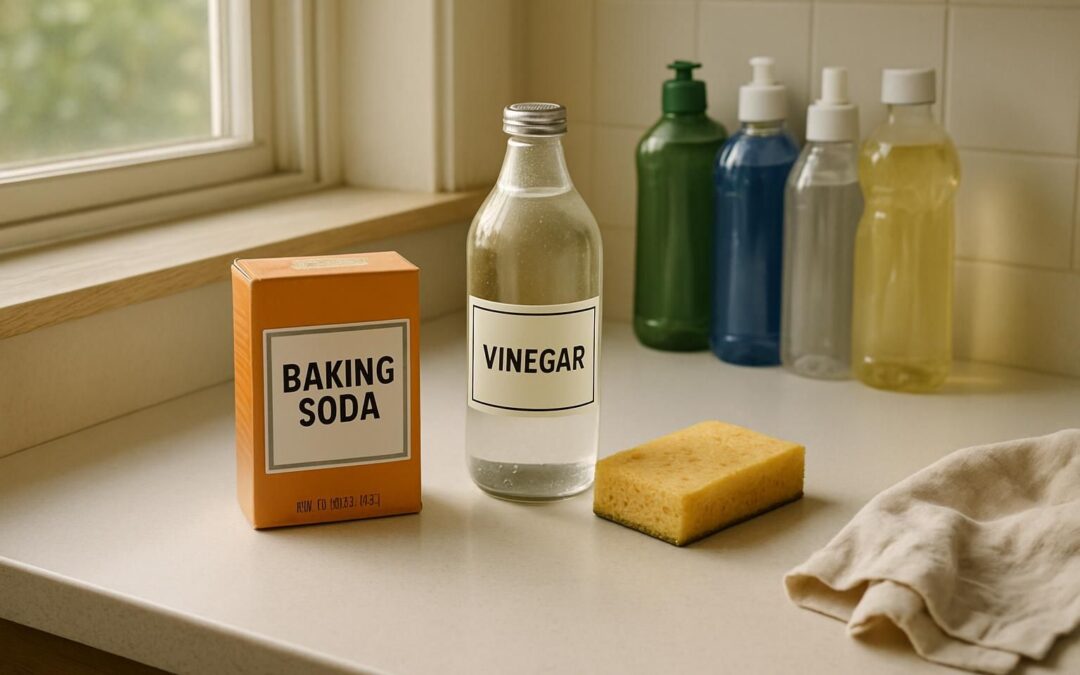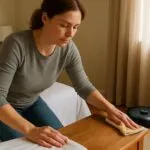Many homeowners deal with tough stains, weird smells, and grime buildup in the kitchen or bathroom. But expensive cleaners are not always best.
Baking soda for cleaning is a smart solution that tackles dirt and odors effectively without harsh chemicals. This simple white powder has alkaline properties that dissolve grease and absorbs unpleasant smells at low cost.
Readers will find easy baking soda cleaning hacks to refresh kitchens, bathrooms, laundry areas, carpets, and more throughout this blog post. Keep reading to discover surprisingly easy tips for a cleaner home.
Table of Contents
- Key Takeaways
- Why Use Baking Soda for Cleaning?
- Baking Soda Cleaning Hacks for the Kitchen
- Using Baking Soda in the Bathroom
- Baking Soda for Laundry and Fabrics
- General Household Cleaning Hacks
- Things You Should Not Clean With Baking Soda
- Conclusion
- FAQs
Key Takeaways
These baking soda cleaning tips and cleaning with sodium bicarbonate methods reflect best practices recommended by baking soda cleaning experts.
- Baking soda is a low-cost, eco-friendly cleaner that tackles over 100 household tasks safely. It removes tough kitchen stains from ovens and stovetops. Freshens refrigerators when replaced every 30 days, and cleans mugs stained with tea or coffee.
- In bathrooms, baking soda clears clogged drains naturally when mixed with vinegar and hot water. It also effectively cleans grout lines and tile surfaces without scratches.
- For laundry purposes, soaking clothes in a half-cup baking soda per gallon of hot water helps remove stubborn stains like grass or sweat. Also adding one cup to the rinse cycle boosts freshness in gym gear or towels.
- Using baking soda regularly deodorizes mattresses by sprinkling evenly across surfaces for at least 30 minutes before vacuuming. Mixing equal parts baking soda with vinegar into paste treats tougher mattress stains from sweat or pet accidents.
- Despite its versatile uses such as carpet odor removal baking soda may cause scratches on smooth glass stovetops if misused. Always test sensitive areas first and avoid combining it with harsh chemical products to prevent damage.
Why Use Baking Soda for Cleaning?
Baking soda kitchen cleaning techniques and baking soda cleaning benefits show that using baking soda for cleaning offers an eco-friendly alternative.
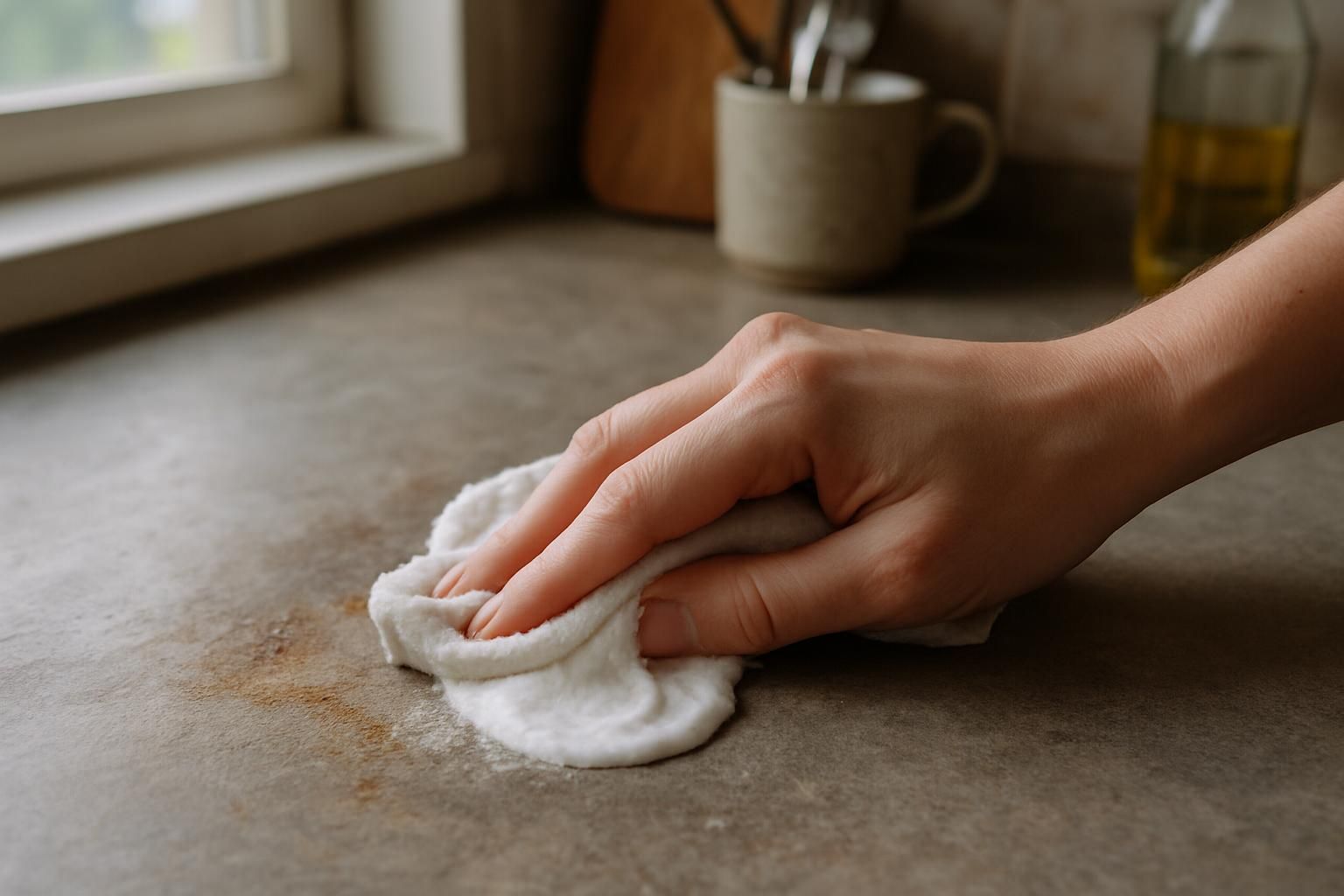
Baking soda, or sodium bicarbonate, stands out as an economical solution for household cleaning. Its alkaline properties help dissolve dirt and grease. While its mildly abrasive texture removes stubborn stains without scratches.
The chemical reactions between baking soda and acids like vinegar or lemon juice produce carbon dioxide gas, making grime easier to wipe away. Baking Soda costs far less than most commercial cleaners and handles over 100 tasks from scrubbing countertops to freshening carpets all naturally and safely.
Baking Soda Cleaning Hacks for the Kitchen
The baking soda cleaning recipes and baking soda cleaning methods deliver reliable results in everyday kitchen cleaning tasks.
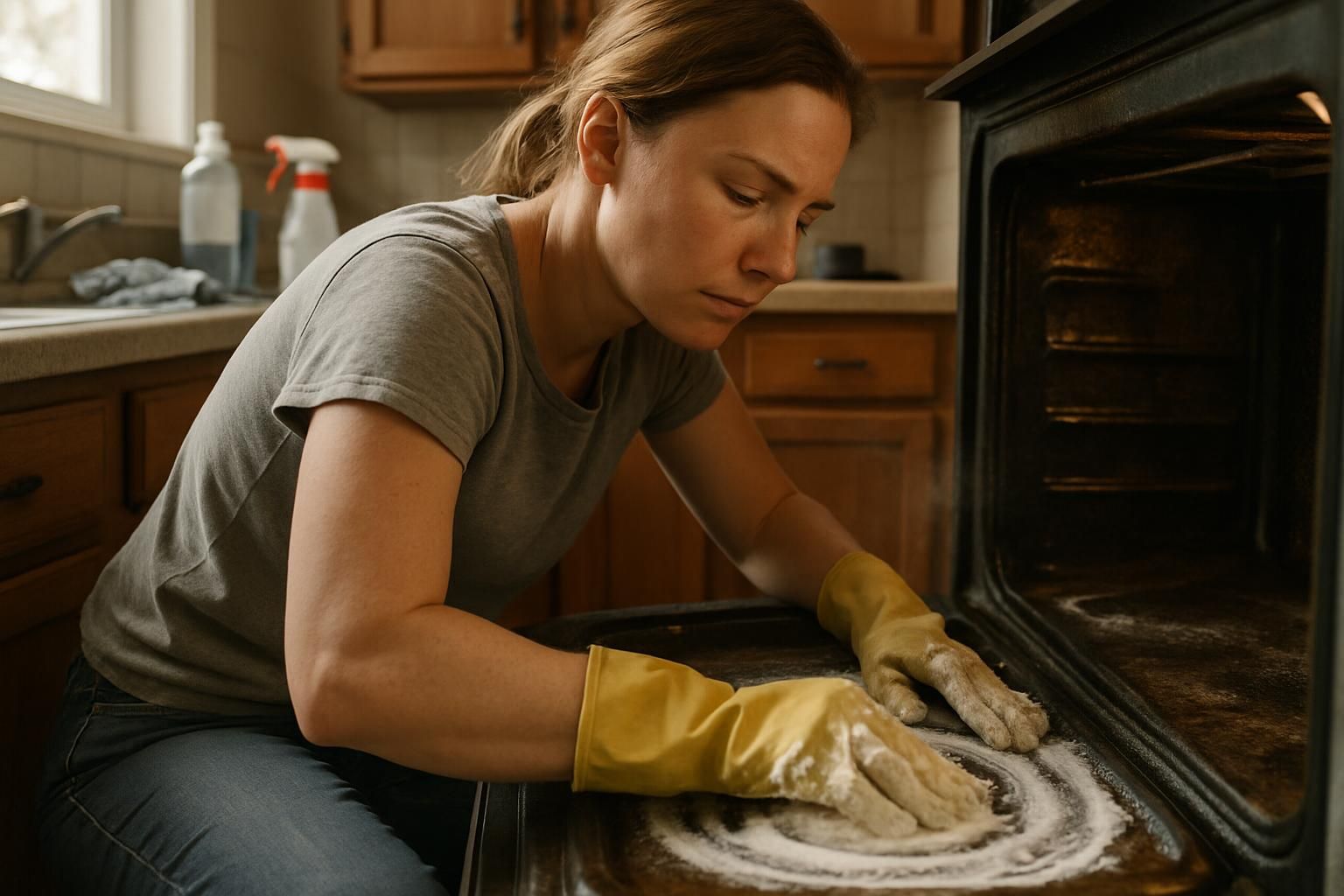
Baking soda is a kitchen superhero that tackles tough cleaning jobs without harsh chemicals. From greasy ovens to smelly fridges, this humble powder makes kitchen cleanup quick and breezy.
Clean Stovetops and Ovens

Everyone loves a clean kitchen, but dirt and grime build up fast. Cleaning ovens and stovetops with baking soda is quick, simple, and cheap.
- Baking soda effectively cleans ovens by breaking down grease and stuck food residue without harsh chemicals.
- To make an oven sparkle, mix half a cup of baking soda with water to create a paste, then spread evenly inside the oven (skip elements).
- Let this paste sit overnight or at least for 12 hours. Wipe it away the next morning with a damp cloth to remove the loosened residue.
- For cleaning tough oven racks, soak them in hot water and baking soda for several hours before scrubbing off grime using a brush or sponge.
- Stove cleaning gets easier too greasy burners become spotless after soaking them in hot water mixed with one-quarter cup baking soda for about 30 minutes.
- Although effective on most surfaces, baking soda can scratch smooth glass stovetops easily. Choose an appropriate stove cleaner that suits glass surfaces instead.
- Regularly using these baking soda hacks helps maintain ovens and stovetops without heavy-duty scrubbing or expensive cleaning products.
- Following these simple kitchen maintenance tips means homeowners spend less time fighting stubborn kitchen stains each day.
Remove Coffee and Tea Stains
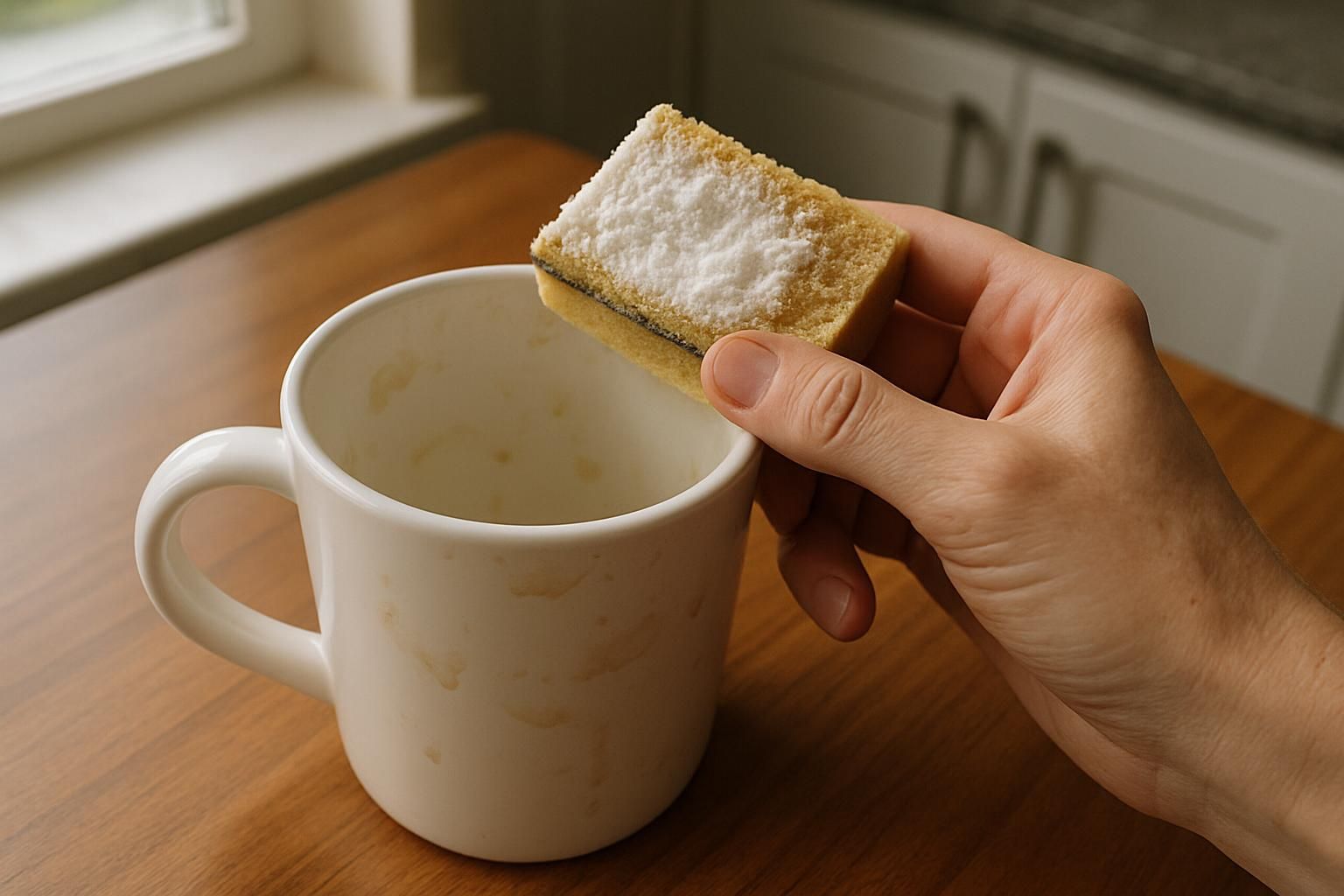
Coffee and tea residue can leave stubborn stains on ceramic mugs. Baking soda cleaning tips for the kitchen offer effective stain removal without harsh chemicals.
- Sprinkle baking soda lightly inside the stained ceramic mug.
- Dampen a soft sponge slightly with water to make it moist but not soaking wet.
- Scrub gently using circular motions to loosen coffee and tea discoloration.
- Rinse the mug completely under warm running water to remove baking soda residue.
- Check for any remaining stains; repeat steps if needed until clean.
- Dry thoroughly with a soft towel or leave upside down on a drying rack to air dry fully.
- Regular use of this handy household cleaning technique helps keep favorite mugs looking new over time.
- This method also works well on other kitchen items stained by beverages, such as teapots, glass cups, and pitchers.
Deodorize Trash Cans and Garbage Disposals
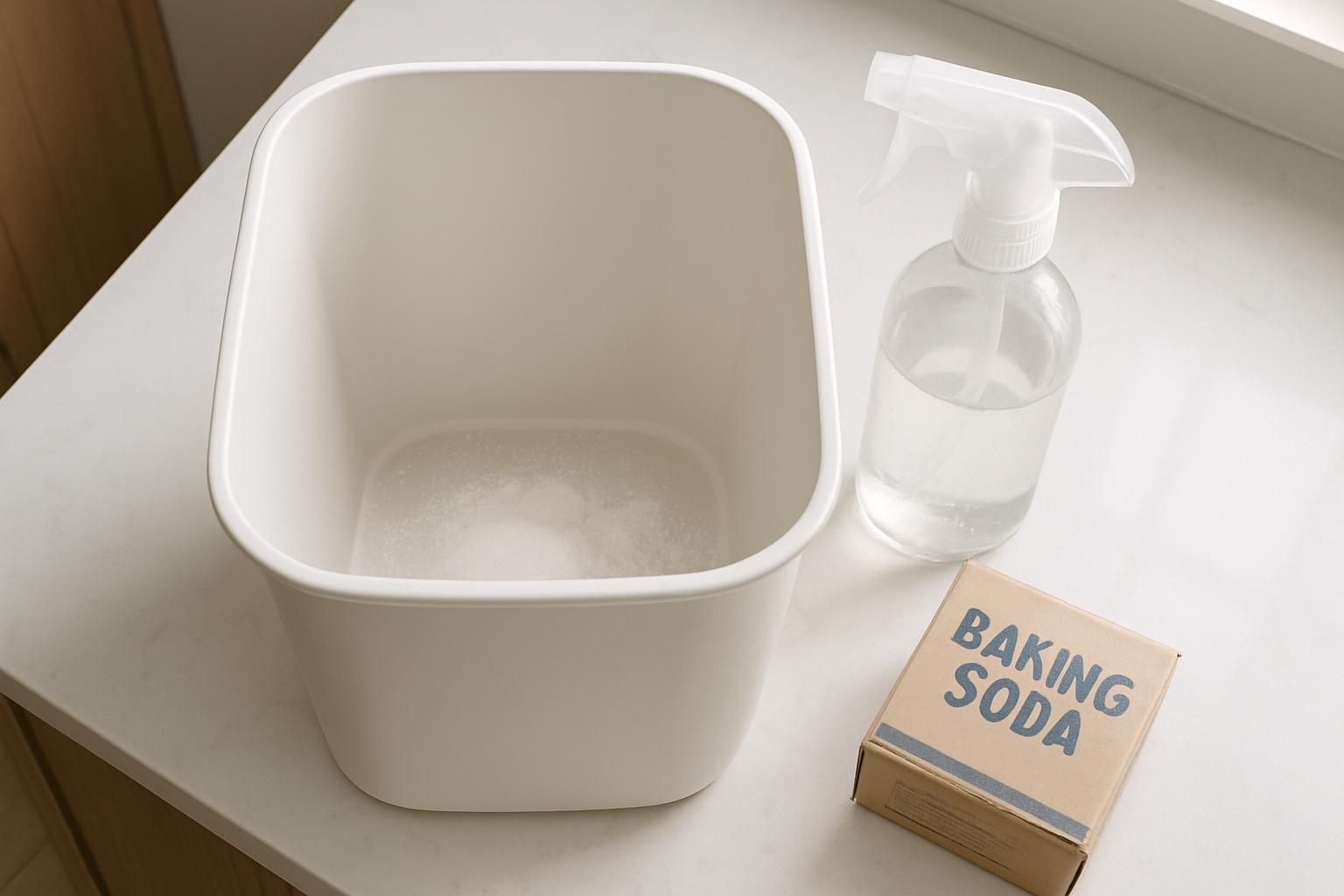
Trash odors quickly turn kitchens into smelly nightmares. Baking soda offers simple solutions to deodorize trash cans and garbage disposals effectively:
- Sprinkle baking soda inside empty trash cans to neutralize kitchen odor control issues.
- Use a clean spray bottle with baking soda and water mixture for sanitizing surfaces inside the garbage can.
- For strong smells, pour 1 cup of baking soda directly into the garbage disposal drain followed by hot water.
- Add white vinegar after baking soda for persistent smells. Let it bubble and fizz, then flush thoroughly with hot water.
- Freshen trash bins weekly by shaking some baking soda directly onto the bottom before adding a new bag.
- Toss several tablespoons of dry baking soda down garbage disposals monthly to manage household cleaning chores easily.
- Repeat as needed between regular kitchen maintenance routines or after disposing of smelly foods like fish or onion peels.
With nasty kitchen odors handled, next comes ensuring cutting boards are safe and clean for food preparation.
Freshen Refrigerators and Freezers
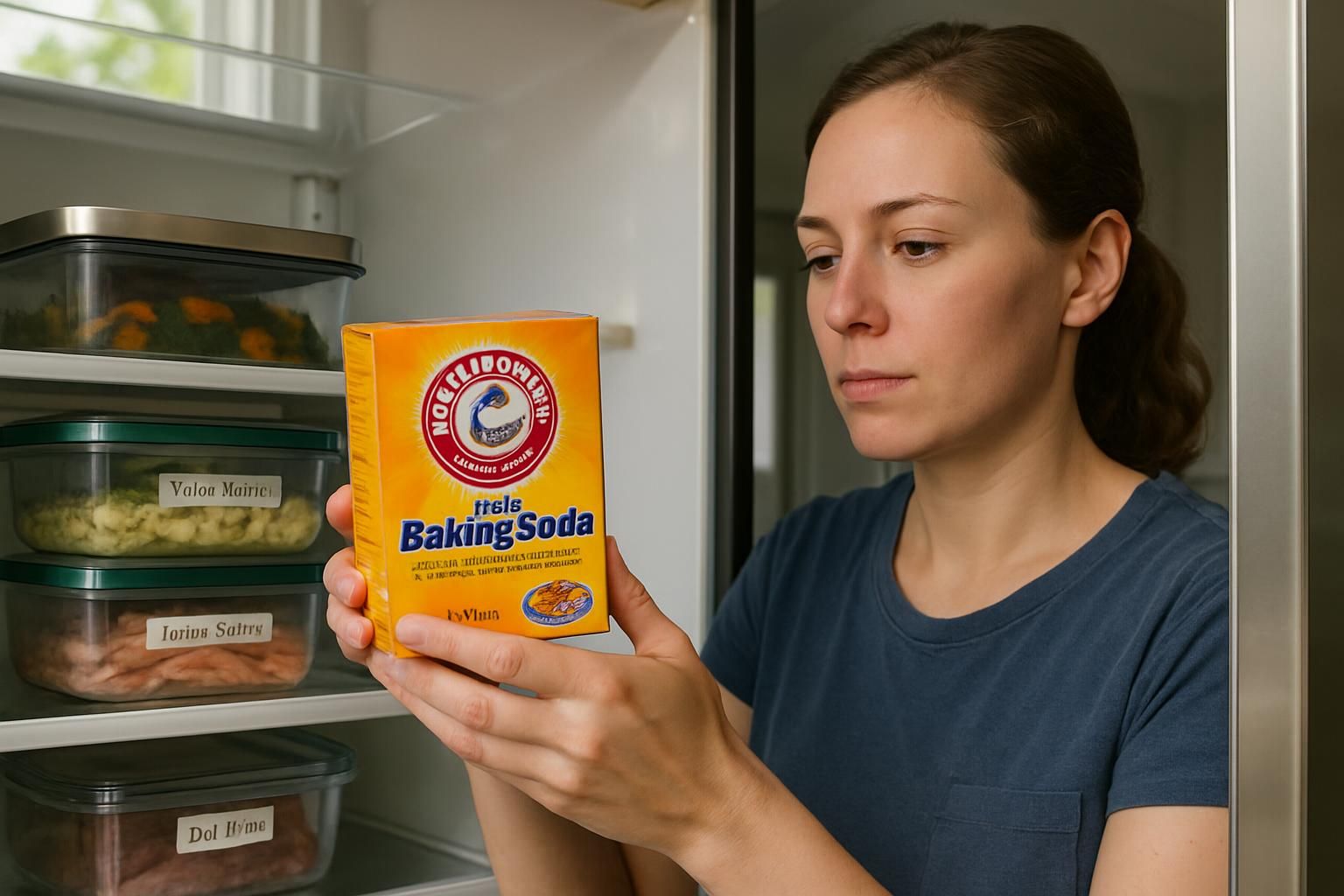
After tackling smelly trash bins, refrigerators and freezers come next. These kitchen appliances easily absorb odors, but baking soda can quickly help with odor control and fridge freshness.
- Place an unopened box of Baking Soda inside the fridge or freezer to eliminate odors effectively.
- Change the baking soda box every 30 days for continuous odor protection and fresh food storage conditions.
- For easy refrigerator organization, clearly mark the date on each new baking soda box.
- Sprinkle baking soda on a damp cloth to gently wipe surfaces for improved kitchen cleanliness without harsh chemicals.
- Use a paste made from three spoons of baking soda and one spoon of warm water to scrub tough spots, stains. Or sticky patches inside refrigerators and freezers after defrosting.
- Spread a thin layer of dry baking soda in empty ice cube trays. Leave overnight before washing them thoroughly with hot water to keep freezer maintenance simple and effective.
- Keep foods like onions, seafood, or strong cheeses tightly covered alongside using baking soda hacks for maximum odor prevention in refrigerators and freezers.
- After power outages or spoiled food events, generously apply dry baking soda directly onto interior surfaces after removing spoiled items. Let it sit for two hours before wiping clean with warm water.
- Households regularly placing leftovers in refrigerators should store opened boxes of Baking Soda at eye level as visual reminders for timely replacements every month.
- Families aiming for optimal food preservation must routinely wipe up spills promptly before they set into refrigerator shelves or drawers to complement the use of their favorite kitchen cleaning product baking soda!
Clean Cutting Boards
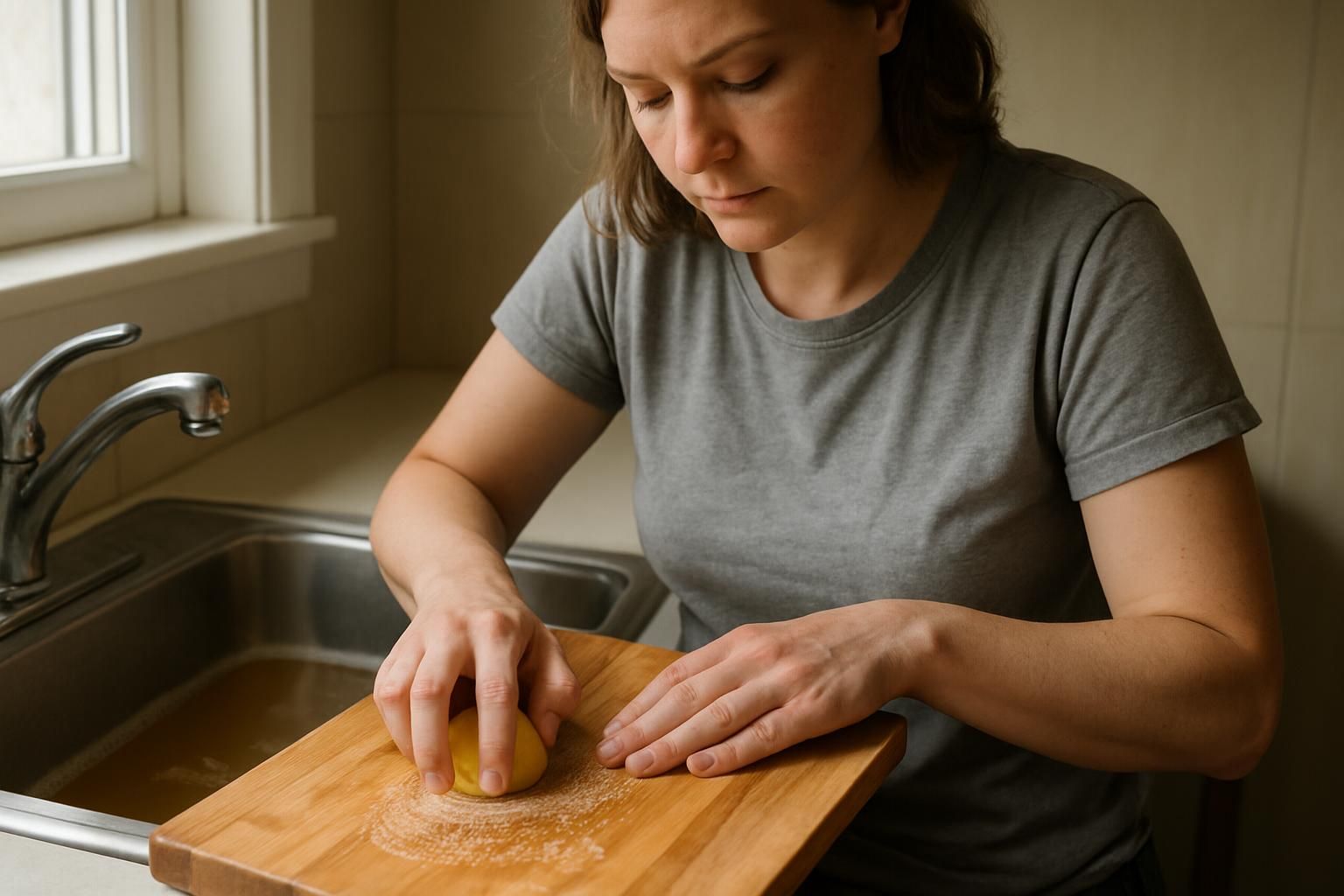
Cutting boards are often a hot spot for kitchen germs. Regular cleaning keeps surfaces safe, but using natural cleaning methods takes kitchen hygiene a step further.
- Wooden cutting boards absorb juices and odors easily, making deep cleaning essential.
- To start a thorough clean, wash the board with warm water and dish soap to remove surface dirt.
- Next, pour baking soda over the entire board generously. It acts as an ecofriendly cleaning solution that removes stains and absorbs unwanted odors.
- Cut half of a fresh lemon the citric acid partners perfectly with baking soda then scrub the surface firmly in circular motions using the lemon’s juicy side.
- Lemon juice combined with baking soda creates a nontoxic antibacterial kitchen hack ideal for sanitizing cutting boards safely and naturally.
- This method neutralizes strong smells from garlic, onion, seafood or raw meat leaving the board fresh without harmful chemicals.
- Rinse the cutting board thoroughly under running water to wash away residue completely so no gritty texture remains.
- Pat dry immediately using a clean cloth to avoid moisture buildup that could warp or damage wood fibers over time.
- For routine maintenance, repeat this DIY cutting board cleaning trick weekly or more frequently after preparing meats, seafood, or pungent foods.
- Using ecofriendly ingredients like lemon and baking soda contributes to green cleaning alternatives helpful especially in households with kids prone to allergies.
With sanitized and odor-free cutting boards ready for cooking tasks ahead, homeowners can confidently tackle another busy part of home cleanup: Using Baking Soda in the Bathroom.
Using Baking Soda in the Bathroom
Baking soda and vinegar cleaning methods serve as effective, natural cleaning solutions for bathroom maintenance.
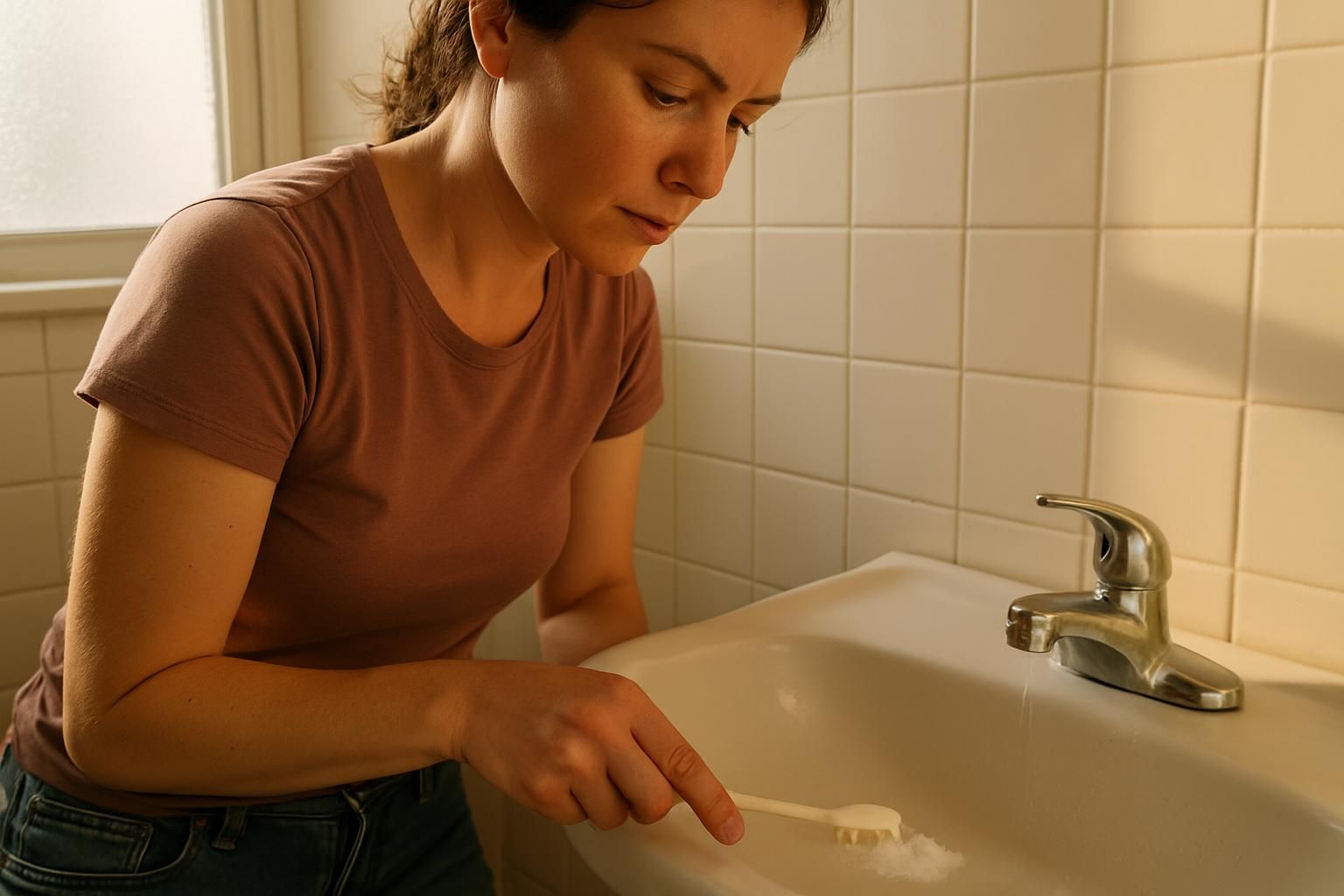
Bathrooms can quickly become messy, but baking soda makes cleaning easy and stress-free. These simple hacks help homeowners keep bathrooms fresh without harsh chemicals or elbow grease.
Unclog Drains
Clogged drains frustrate homeowners and risk expensive home plumbing issues. Baking soda offers an easy fix as a natural drain cleaner that’s perfect for DIY unclogging.
- Pour 1/2 cup baking soda directly into the blocked drain.
- Follow quickly with 1/2 cup white vinegar and watch it fizz, helping to break down drain blockages.
- Let the mixture sit for 30 minutes, giving it time to work deeper into the clog and clear pipes naturally.
- After half an hour, flush the drain thoroughly with hot water to wash away loosened debris and restore normal flow.
- Baking soda works safely in both kitchen sink clogs and bathroom maintenance, leaving pipes fresh without harsh chemical odors or dangerous fumes.
- Regular use of this ecofriendly method maintains pipe health long-term, reducing household plumbing problems while saving money on professional plumbers.
- Natural cleaning methods like vinegar and baking soda offer parents peace of mind against harmful ingredients found in store-bought chemical cleaners.
- This simple household remedy also prevents future buildup by gently scraping residue off pipe walls every time it’s used.
- Even tough shower drain blockages caused by hair or soap scum respond well to this approach if repeated monthly as part of regular bathroom upkeep routine.
- Clear, smooth-flowing pipes create a more pleasant living space free from foul odors caused by trapped waste buildup inside clogged drains.
Clean Grout and Tiles
Grout can stain quickly and tiles lose their shine easily. Baking soda makes tile and grout cleaning much simpler, safer, and cheaper.
- A baking soda paste works wonders for grout cleaning. Mix baking soda with water into a thick consistency similar to toothpaste.
- Apply the baking soda paste onto stained grout using an old toothbrush or small scrubbing brush for precise coverage.
- Let this baking soda solution sit on dirty areas of grout lines for at least 10 minutes before scrubbing to lift dirt and grime effectively.
- Scrub the grout lines thoroughly with a firm-bristled toothbrush; steady back-and-forth brushing action removes built-up grime fast without scratching tiles or damaging grout surfaces.
- Rinse off leftover residue from grout and tiles completely with warm water afterward, preventing any leftover gritty feel underfoot or on hands later on.
- Mop tiled bathroom floors regularly using half a cup of baking soda dissolved in warm water for effective maintenance; this keeps lightly soiled floors shiny while gently deodorizing them at once.
- For tougher tile discoloration inside showers or around bathtubs, simply sprinkle dry baking soda directly onto problem spots first. Then follow up immediately with damp sponge wiping motions until stains fade away naturally without using harsh chemicals that could harm children or pets nearby.
- Regular tile floor care routines that use natural products like baking soda help extend tile life and enhance overall bathroom cleanliness safely. Specially for family homes busy with messy kids or energetic pets playing indoors every day.
Freshen Sinks and Bathtubs
Baking soda makes bathroom maintenance quick and easy. Homeowners looking for ecofriendly cleaning options can give sinks and bathtubs a simple refresh with baking soda scrub.
- Sprinkle half a cup of baking soda evenly across the bathtub or sink surfaces, coating all stains or soap residue completely.
- Dampen a sponge slightly under water, then scrub sinks and bathtubs in circular motions for a thorough yet gentle clean.
- Add some white vinegar to increase cleaning power. This natural cleaning solution will fizz up briefly to cut through grime better.
- Wait around five minutes after scrubbing, allowing baking soda mixture enough time to lift dirt before rinsing thoroughly with warm water.
- Clean faucets by applying a paste of three parts baking soda and one part water. Polishing gently afterward to remove buildup and leave fixtures bright.
- Use an old toothbrush dipped in baking soda paste to reach corners near drains effectively. This quick step helps promote proper bathroom sanitation regularly.
- Place an open container with about one cup of baking soda on countertops between deep cleans. It absorbs moisture and unpleasant odors naturally without chemical cleaning agents.
- Always rinse off any remaining baking soda carefully after each use to avoid leaving gritty residue behind that may feel uncomfortable later during baths or handwashing routines.
- After rinsing everything clear, dry surfaces entirely using soft dry towels. Dryness prevents mold growth while maintaining bathrooms fresh longer as part of routine DIY bathroom cleaning tasks homeowners do weekly.
- Follow the simple approach outlined above consistently. So families enjoy safe bathroom spaces cleaned with nontoxic products rather than harsh commercial brands affecting health negatively over time.
Clean Showerheads and Remove Limescale
Showerheads easily clog with hard water stains and calcium buildup. Homeowners can quickly solve this issue with a simple baking soda cleaning hack.
- Fill a plastic bag halfway with white vinegar, then add two tablespoons of baking soda to the mixture.
- Quickly place the bag around the showerhead so that it fully covers all clogged areas filled with limescale deposits.
- Secure the top of the plastic bag tightly using a rubber band or twist tie, allowing the vinegar solution to stay firmly in place overnight.
- After at least eight hours (an overnight soak works best), homeowners should remove and discard the plastic bag carefully.
- Turn on warm water through the nozzle for two full minutes to flush out any remaining deposits loosened by the soaking mixture.
- Wipe down showerhead surfaces gently yet thoroughly using an old toothbrush or soft cloth dipped lightly into baking soda paste if stubborn build-up remains.
- Dry off cleaned surfaces completely afterward to avoid new mineral buildup from forming soon after cleaning finishes.
- Regular maintenance once every month helps keep household showerheads free from tough limescale troubles. While extending appliance lifespan and performance quality significantly over time.
Baking Soda for Laundry and Fabrics
Baking soda cleaning clothes benefits and a baking soda cleaning solution recipe provide a green choice for stain removal and odor control.
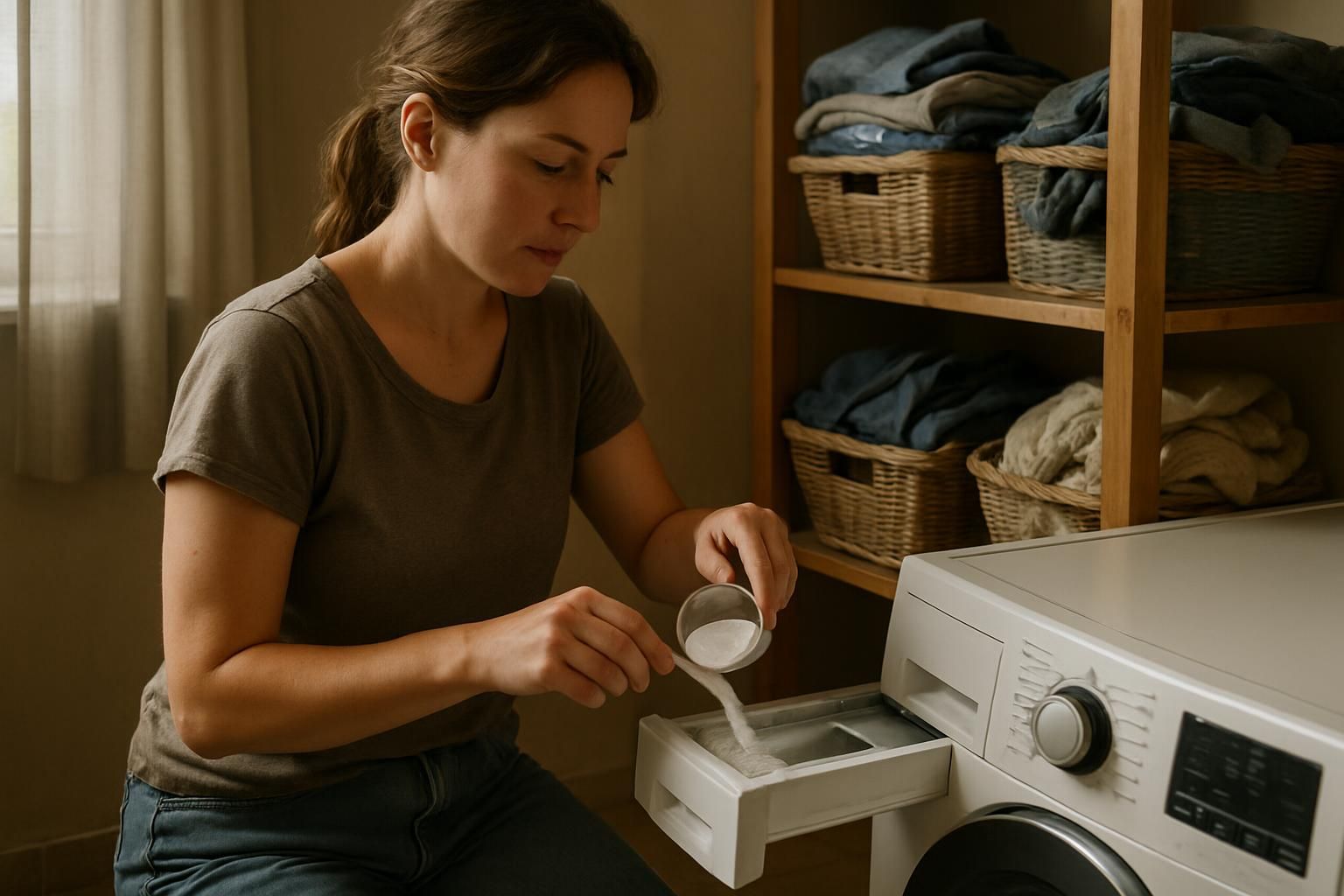
Laundry day becomes simpler when baking soda joins the party. This household staple can lift stains and freshen fabrics without harsh chemicals making life easier for busy parents.
Pre-Soak Stained Laundry
Parents and homeowners often struggle with stubborn laundry stains. Baking soda provides an effective, natural solution for stain removal through a simple presoak method.
- For tough fabric stain removal, fill a basin or bucket with hot water and baking soda; use a half cup baking soda per gallon of hot water.
- Hot water helps baking soda dissolve quickly, breaking down stains in clothing fibers.
- Soak stained clothing fully submerged in the mixture, keeping colors similar together to prevent color bleeding.
- Allow garments to soak for at least 2 hours; soaking overnight can boost stain-removal results even further.
- Check fabric care labels before soaking to avoid shrinking or harming delicate materials such as silk, wool, or rayon.
- After soaking clothes completely, remove items from baking soda laundry soak, rinse well with warm water, and launder normally in washer.
- Adding a small amount of detergent into the presoak enhances cleaning power for extra dirty clothes like children’s sports uniforms or workwear.
- Baking soda also helps neutralize strong odors during laundry pretreatment ideal for gym gear or bedding fabrics needing fabric freshening.
- Parents find this method safer than harsh chemicals often found in commercial stain removers since baking soda is harmless to kids and pets.
- If certain tough stains remain partially visible after one soak, repeat the laundry soaking process once more before drying garments permanently sets stains into fabric fibers.
Boost Laundry Detergent Effectiveness
Laundry detergent does a decent job, but baking soda makes it shine. Adding baking soda gives clothes extra freshness, softness, and stain removal power.
- Sprinkle half a cup of baking soda directly into the washer drum before putting in clothes; this step boosts odor removal noticeably.
- Toss one cup of baking soda into the rinse cycle to eliminate lingering smells completely from fabrics like sports gear or towels.
- Mix laundry detergent with a quarter cup of baking soda before washing heavily soiled uniforms or play clothes for brighter colors and stronger stain-fighting results.
- Combining laundry additives such as fabric softeners with half a cup of baking soda produces softer fabrics without irritating sensitive skin.
- For powerful fabric freshness and odor elimination on mattresses or curtains, sprinkle baking soda generously on surfaces; leave overnight, then vacuum thoroughly the next morning.
- Include half a cup of baking soda regularly with sheets and pillowcases; this helps remove sweat odors effectively while gentle on delicate fibers.
- Add one full cup of baking soda during pre-soak stages when treating stubborn stains like grass or food spills; it loosens stains effortlessly for thorough cleaning.
Now the magic doesn’t stop at laundry the rest of your house can sparkle too!
Deodorize and Freshen Mattresses
After boosting their laundry detergent, homeowners can tackle another common task keeping mattresses smelling clean and fresh. Baking soda offers a simple fix for mattress odors and stains.
- First, sprinkle baking soda evenly over the mattress surface to deodorize odors and moisture trapped in its fibers.
- Allow the baking powder to sit on the mattress for at least 30 minutes. Overnight works best if strong smells need treating.
- Vacuum thoroughly afterward to lift away all traces of powder along with dirt, dust mites, and odor-causing particles.
- For tougher mattress stains from sweat, pets, or accidents, mix equal amounts of baking soda with white vinegar until it forms a soft paste.
- Spread this mixture lightly onto stained areas, giving time (usually 20 to 30 minutes) for vinegar’s gentle acidity to break apart stain residues.
- Gently rub off dried paste using a damp cloth or sponge before letting the mattress fully air-dry again.
- Regularly repeating this simple cleaning hack helps parents maintain healthier sleeping conditions without harsh cleaning products or expensive chemical sprays.
General Household Cleaning Hacks
Baking soda household uses include versatile applications in carpet cleaning and silverware polishing. Spray options enhance ease of use across various cleaning tasks.

Baking soda can tackle tricky household messes you never thought you’d solve. With a few clever tips, homeowners will soon see this simple white powder in a whole new light.
Remove Carpet Odors and Stains
Carpet odors and stains make rooms feel less inviting. Homeowners tackle these issues easily using baking soda.
- To eliminate carpet odors, sprinkle baking soda generously over the carpet surface. Let the powder sit for at least 30 minutes to absorb carpet odors fully before vacuuming it up.
- Baking soda also helps clean carpet stains effectively, especially fresh spills like juice or coffee. To remove carpet stains, blot wet spills first to soak up extra liquid, then lightly apply baking soda to the damp spot and wait 15 to 20 minutes before vacuuming.
- For tougher spots like grease marks or mud, homeowners may create a simple cleaning paste by mixing equal parts of baking soda and water. After gently rubbing the paste into the stain with a soft brush, let it dry thoroughly and vacuum afterward.
- Households dealing frequently with pet odors can deodorize carpets safely using baking soda instead of harsh chemical products that irritate pets or children.
- Rugs placed in entryways often trap shoe smells and dirt easily; families freshen rugs weekly by spreading a thin layer of dry baking soda over them at night and vacuuming in the morning.
- Carpets in kids’ playrooms get messy quickly from spilled snacks or crafts; quick sprinkling of baking soda works wonders absorbing those lingering smells after cleanup.
- DIY carpet cleaning techniques involve placing small boxes filled with open lids containing baking soda discreetly around musty basements or closets where carpeting absorbs stale air freshness continually without much work required from busy parents.
- Each pound of plain household-grade baking soda costs about one dollar as of late 2023 according to local grocery estimates more affordable than specialty odor removal products sold at stores and each standard-sized box goes far enough for multiple cleanings around any family home throughout the year.
- Studies from household care experts suggest regular use of natural odor absorbers like baking soda lowers exposure risks compared to commercial cleaners loaded with strong chemical fragrances harmful for sensitive individuals or those prone to allergies within households having younger children running about daily indoors.
- Families may conveniently keep an extra box handy near main living areas ready-to-use anytime spills occur unexpectedly during parties or everyday activities.
Polish Silverware
Silverware can quickly look dull and tarnished, which frustrates many homeowners. Baking soda is a simple, budget-friendly item that polishes silver effectively to restore shine.
- Start by mixing baking soda with water in equal amounts to make a thick paste.
- Spread this baking soda paste carefully onto the silver items with a soft cloth or sponge.
- Allow the baking soda paste to sit undisturbed on the silverware surface for up to 10 minutes.
- Next, thoroughly rinse off all traces of baking soda using warm water.
- After rinsing, use a dry, clean cloth to gently buff each silver piece until it shines nicely again.
- Avoid applying this method on oxidized or antique silver pieces, since baking soda removes desired patina from these valuable items; choose instead a dedicated silver cleaner from your local grocery store or online retailer.
- Adults should handle this process because younger children might accidentally scratch delicate surfaces or ingest cleaning substances by mistake.
- This easy household cleaning hack restores beauty and shine without expensive polishing products or chemicals, saving parents money for other useful things around the house.
Absorb Refrigerator Odors
Nobody enjoys opening their refrigerator and smelling last week’s leftovers. Baking soda can quietly work wonders to absorb odors and keep those fridge smells from taking over.
- Many house owners place an unopened box of ARM & HAMMER Baking Soda inside their refrigerators to absorb refrigerator odors.
- Baking soda doesn’t simply mask fridge smells it neutralizes them naturally, leaving the air fresh.
- Homeowners need only change out the box roughly every 30 days for continued odor control throughout the month.
- House owners appreciate baking soda since it’s safe around food, pets, and children perfect for family kitchens.
- Baking soda also helps prevent strong-smelling foods like onions or garlic from affecting other items inside the fridge.
- Parents find baking soda especially useful in neutralizing spoiled milk smells or leftover baby food aromas that often linger too long.
- Placing baking soda at the back of shelves rather than in door compartments offers better airflow and noticeably improves effectiveness against stubborn smells.
- Open bowls or shallow containers with baking soda also absorb odors effectively if space is limited or no unopened box is available on hand.
- For busy parents and homeowners looking for effortless household cleaning hacks, keeping ARM & HAMMER Baking Soda always ready makes scent control easier than ever before.
Things You Should Not Clean With Baking Soda
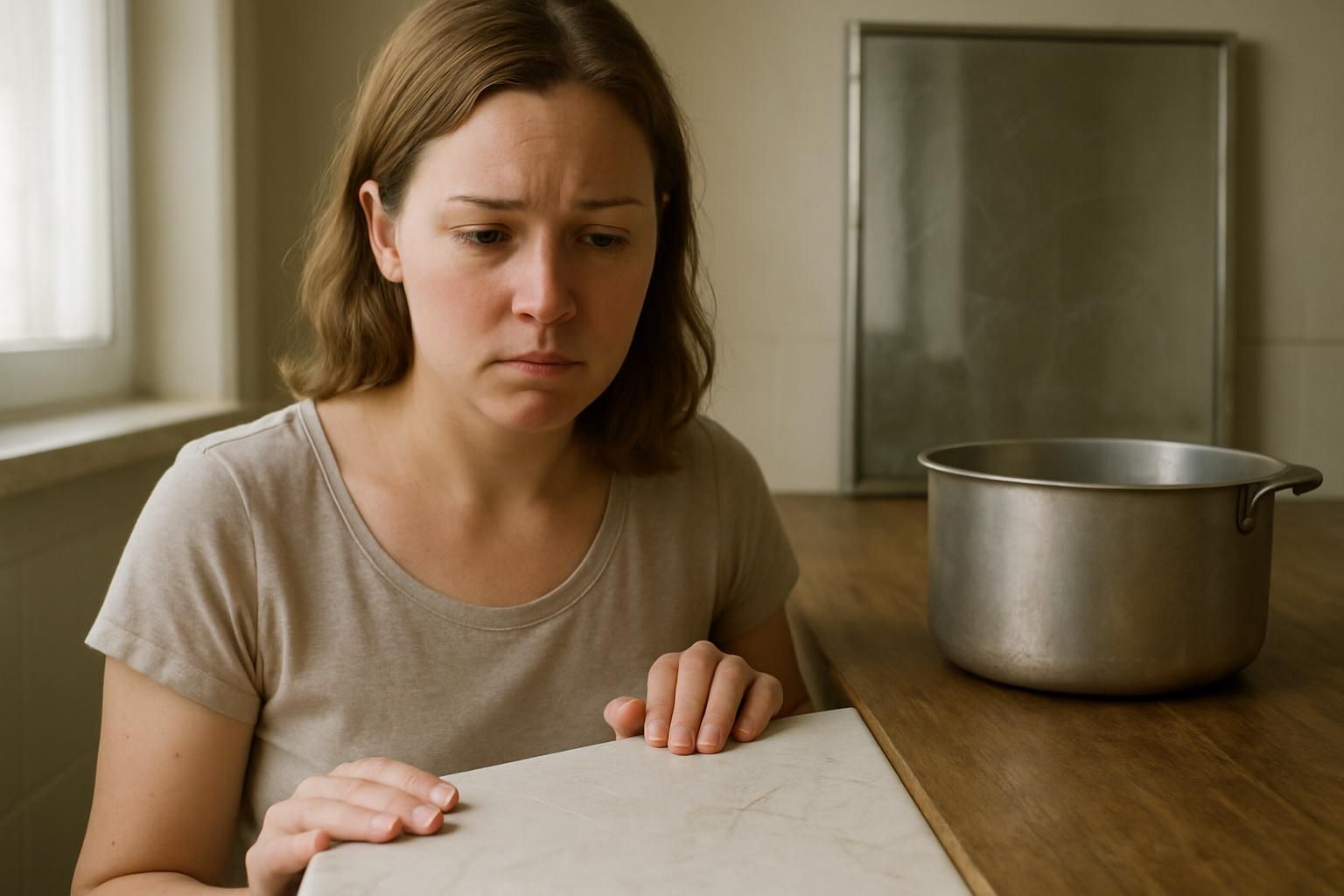
Baking soda is a great cleaner, but some surfaces just won’t tolerate it. Surfaces to avoid cleaning with baking soda include aluminum cookware and marble counters because its abrasive nature may dull or damage their finish.
Glass items, like mirrors or windows, can get scratched up from baking soda’s gritty texture. Finished wood furniture and certain stovetops also suffer harm if baking soda wears down their protective layers.
Electronic devices, gold-plated objects, soft gemstones such as pearls and opals, and natural stone materials also require gentler care clean these delicate items without using baking soda at all costs.
Never combine baking soda with chlorine bleach, ammonia or hydrogen peroxide in sealed containers since harmful gases could form.
Conclusion
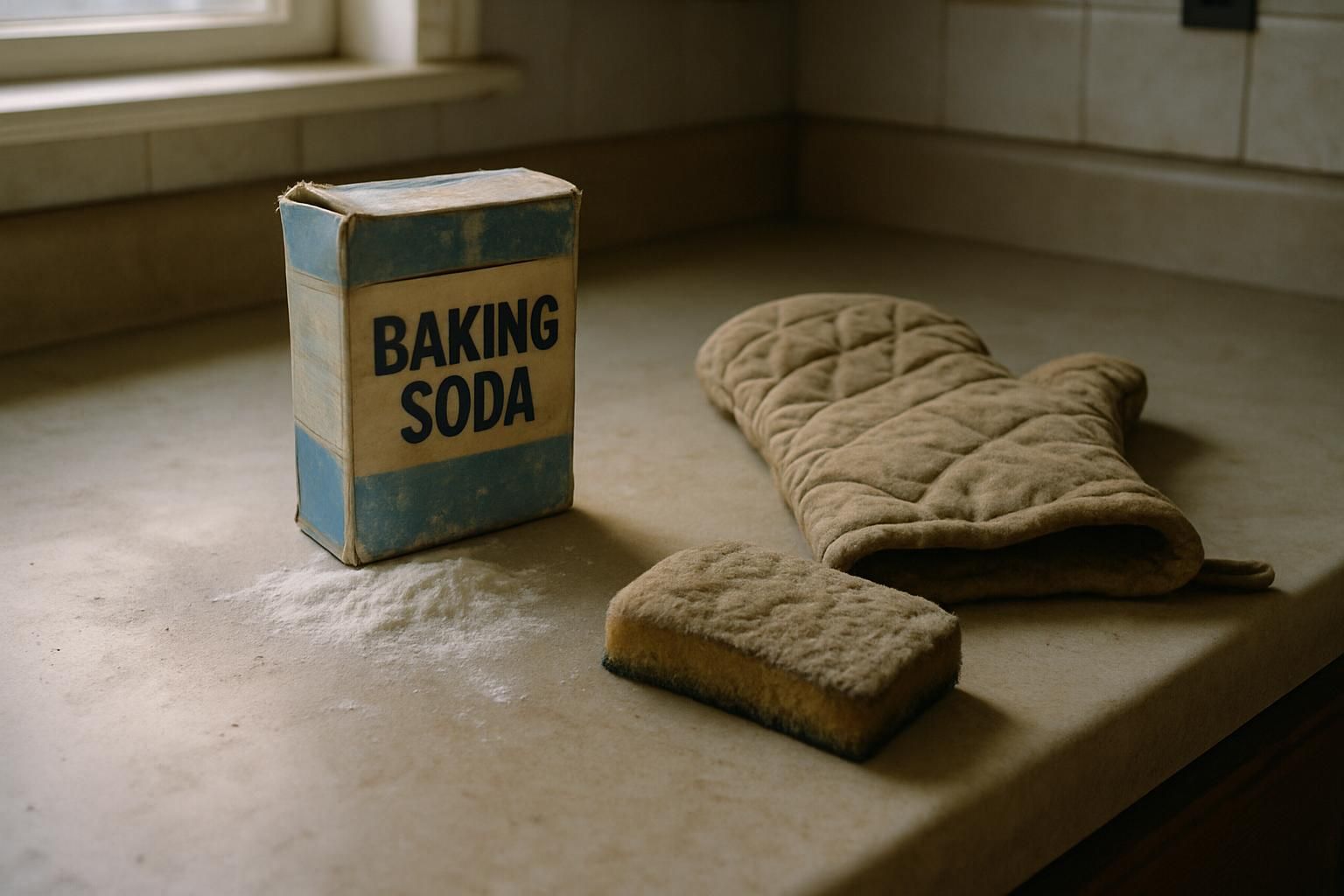
Simple baking soda offers homeowners a safer, cheaper way to keep homes fresh and clean. Its uses range from banishing foul odors to tackling stubborn stains. Yet caution counts; avoid applying it on sensitive surfaces or mixing with harsh chemicals.
By adding these handy hacks into cleaning routines, parents can make chores quicker and greener and maybe even a bit less dull. Let this ordinary kitchen staple brighten the cleaning routine around any home.
FAQs
1. Can baking soda really remove tough stains from surfaces?
Absolutely! Baking soda is a cleaning powerhouse for stubborn stains on counters, sinks, and even carpets. Sprinkle it directly onto the stain, add some water to form a paste, then scrub gently with a sponge or cloth.
2. How do I use baking soda to freshen up my fridge?
Easy as pie! Just place an open box of baking soda in your refrigerator to absorb odors naturally. Swap it out every month or two for best results and say goodbye to funky smells.
3. Is baking soda safe enough for cleaning kitchen appliances?
Totally safe and effective too! Mix baking soda with warm water into a gentle paste and wipe down ovens, microwaves, coffee makers or blenders without worry about harsh chemicals damaging your gear.
4. What’s the trick to unclogging drains using baking soda?
Here’s the scoop: pour half a cup of baking soda followed by one cup vinegar down your clogged drain; wait 15 minutes while they fizz like crazy before flushing thoroughly with hot water problem solved without calling in costly help!

